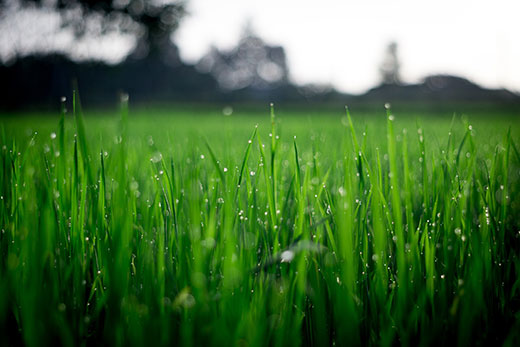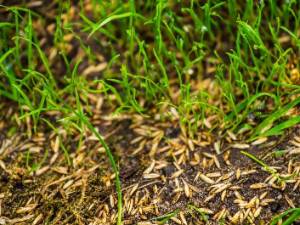Cool Season Lawn Fall Maintenance

Fall is the most important time to fertilize and the best time to re-seed or over seed your cool season lawn. Let’s talk about some important activities for the month of September.
September is the most important time of year to fertilizer your lawn with a high nitrogen fertilizer. Fall is the time when grasses are working on growing a root system and storing nutrients to make it through the winter. In the fall use a quick release type of fertilizer to give the plants a boost going into the winter. It’s important to note that you should be watering your lawn so it is actively growing, especially this year where it has been so hot and dry. Never fertilizer your lawn when the grass is dormant as the grass will not be able to take up the nutrients and they will be lost. Both Tall Fescue and Kentucky Bluegrass lawns should be fertilized with 1-1.5 pounds of Nitrogen per 1000 square feet. in September. You can also fertilize the lawn again in November.
Fall is the best time to re-seed cool season lawns. The grasses have adequate time to get established before winter arrives but you also won’t have to water as much because the temperature is cooler with the potential for more frequent rains. Test the soil before you plan to plant the seed so you can add the appropriate nutrients to the soil prior to planting. To re-seed a lawn, spray the area several weeks before to kill the existing grass and weeds. You may have to spray several times to make sure you have killed the whole area so be sure to start early enough to allow for this. Once every thing is dead, mow the area as short as possible and bag the clippings to make it easier for the grass seed to contact the soil. Tilling lightly on the surface is also an option depending on the size of the area, you don’t have to till it very deep just rough up the soil surface. Seed the grass according to the recommended rate for that type of grass. Keep the area damp until the seeds have started to germinate then slowly back off on watering as the grass grows. Mow the grass once it reached the optimal height for that type of grass.
adequate time to get established before winter arrives but you also won’t have to water as much because the temperature is cooler with the potential for more frequent rains. Test the soil before you plan to plant the seed so you can add the appropriate nutrients to the soil prior to planting. To re-seed a lawn, spray the area several weeks before to kill the existing grass and weeds. You may have to spray several times to make sure you have killed the whole area so be sure to start early enough to allow for this. Once every thing is dead, mow the area as short as possible and bag the clippings to make it easier for the grass seed to contact the soil. Tilling lightly on the surface is also an option depending on the size of the area, you don’t have to till it very deep just rough up the soil surface. Seed the grass according to the recommended rate for that type of grass. Keep the area damp until the seeds have started to germinate then slowly back off on watering as the grass grows. Mow the grass once it reached the optimal height for that type of grass.
This summer has been especially hard on lawns and it might be necessary to over-seed this fall. To prepare the area mow the lawn at 1-1.5” in height and bag the clippings to allow for good seed to ground contact. If there is a heavy thatch build up remove the thatch either with a rake or you can rent a power rake to remove the thatch. You should then use one of these three methods to further prepare the soil:
- A verticut machine has solid vertical blades that can be set to cut furrows in the soil.
- A slit seeder is a type of verticut machine that can prep the soil and drop seeds in the same pass.
- A core aerator punches holes in the soil and deposits the soil cores on the surface of the ground.
Of the three the slit seeder is probably preferred because you can do it all in one pass but any of the above options will work. Once the ground is prepared and seeded care for the grass like you would a new lawn area.
Even though our grasses are probably looking a little rough right now we can take several steps this fall to ensure that they are in tip top shape for the coming growing season. If you aren’t already be sure to water your lawn at least a ½” every week or two to keep the crows of the grass alive

